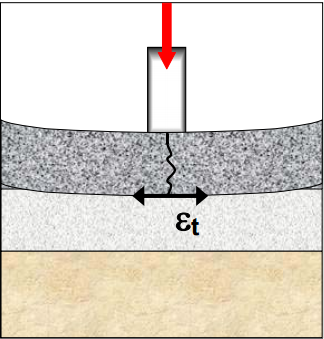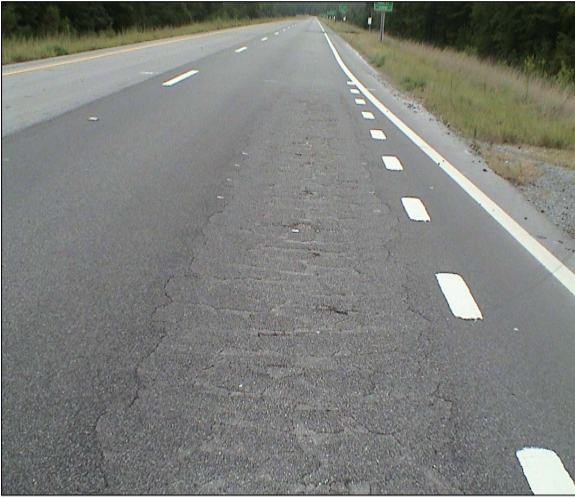Fatigue Cracking of Pavement
Introduction to fatigue cracking of pavement
Fatigue or alligator cracking is the most common type of pavement distress, it is infact the major one. This is the type of distress in which series of interconnected cracks appears due to the fatigue failure of the HMA surface when the pavement experience repeated traffic loading. These type of cracks later allow moisture infiltration into the pavement, the road surface gradually gets more rough, the infiltrated moisture then again accelerate the existing cracking which in worst case may end up being a small to large sized pothole.
In other words, as the traffic loads get repeated on the pavement, fatigue cracking starts to initiate at the bottom of the flexible layer, which accounts for the tensile strains at the bottom of the HMA layer (Huang 1993). Researchers suggested that, for the M-E structural design process of pavement, this tensile strength must be kept in limit in order to check against fatigue cracking (Shook,1982).

Figure 1: Schematic diagram of Fatigue Craking Mechanism in Pavement Cross Section (Priest et al., 2006)
Apart from the repeated stresses incurred upon the pavement surface, fatigue cracking may take place due to aging, temperature changes or inadequate drainage. The effects of these factors are really complicated which my lead to undesirable changes to asphalt, associated with the poor durability properties of the HMA layer. (Finn 1967). Though due to previous research, it was believed that, most of the cracks initiates at the bottom and then make its way to the top of the asphalt layer, which is also termed as ‘bottom up” fatigue cracking, recent studies shows that, in most cases, cracks initiates at the pavement surface on the wheel path and then make its way down to the bottom (Myers and Roque, 2001).
Federal Highway Administration’s Distress Identification Manual for the Long-Term Pavement Performance Program mentioned about three levels of severity for fatigue cracking, which are high severity fatigue cracking, moderate severity fatigue cracking and low severity fatigue cracking. High severity fatigue cracking is the ultimate stage of fatigue cracking. When the pavement has been stressed to the limit of its fatigue life, it is no longer attractive and is barely functional. This stage is called high severity of fatigue cracking. In this case, the cracks are formed in large areas and there are several pieces of loose surface asphalt. Pavement in this condition needs repair immediately. Moderate severity fatigue cracking is the stage when distinguished the arrival of connecting cracks are well recognized. The cracks tends to increase gradually and lower layers of road materials become evident. Heavy traffic load usually break the surface asphalt layer in pieces. Low severity fatigue cracking usually indicates an area of asphalt having only small cracks with very few or none of them connecting to display the zig zag alligator type shape. Also the cracks are not evidently removing lower layers of the road materials. (Miller, 2003)

Figure 2: Fatigue Cracking in Pavement (Priest et al., 2006)
Over the years, the researchers are trying to come up with a simple and standard fatigue testing procedure as till this date, there is no such standard test for fatigue cracking, as different states are evaluating performance against fatigue cracking differently. Tangella et el (1990), came up with an equation to measure the fatigue life, which also accounts for the varying temperature and loading frequency.
Nf= k1 (1/εt)^k2 (1/E)k3
Where, Nf= Number of load cycles until fatigue failure
εt= Applied horizontal tensile strain
E= HMA mixture stiffness
K1,k2,k3= Regression constant
In their study, they emphasized on the flexural fatigue test, diametral fatigue, and tests employing fracture mechanics principals, as the most promising test procedures to characterize fatigue cracking. Later till this period, there are different test procedures such as, Overlay (OL) test, Indirect Tension (IDT) test, Direct Tension (DT) test, Semicircular Bending (SCB) test, are most commonly used to categorize fatigue cracking in the lab. In addition, comparison with the observed result with the field cores is also important. Hajj et al. (2005) emphasized on the mechanistic analysis to understand the interaction between structure, stiffness, and laboratory testing so that a balance can be made for the given field and traffic conditions on a per-project basis. They concluded that, as the field pavement has stiffer structure which will generate lower strains under traffic therefore a longer fatigue life will be observed in the field. Therefore, an overall study is required to characterize fatigue cracking of the pavement.
.
References:
- Huang, Yang H. Pavement Analysis and Design New Jersey: Prentice Hall,1993
- Shook, J.F., F.N. Finn, M.W. Witczak, and C.L. Monismith. “Thickness Design of
Asphalt Pavements – The Asphalt Institute Method,” Proceedings, 5th International
Conference on the Structural Design of Asphalt Pavements, Vol.1, The Netherlands,
1982, pp. 17-44. - Miller J.S., Bellinger W.Y. ”Distress Identification Manual for the Long-Term Pavement Performance Program (Fourth Revised Edition)”, Technical Research Report FHWA-RD-03-031. Federal Highway Administration 6300 Georgetown Pike McLean, VA 22101-2296, 2003.
- Priest A.L. Timm D.H. ”Methodology And Calibration Of Fatigue Transfer Functions For Mechanistic-Empirical Flexible Pavement Design”, NCAT Report 06-03. National Center for Asphalt Technology, Auburn University, Alabama, 2006.
- Tangella, R., J. Craus, J. A. Deacon, and C. L. Monismith. Summary Report on Fatigue Response of Asphalt Mixtures. TM-UCB-A-003A-89-3, SHRP Project A-003-A. University of California, Berkeley: Institute of Transportation Studies, 1990
- Hajj, E. Y., P. E. Sebaalay, and D. Weitzel. “Fatigue Characteristics of Superpave and
Hveem Mixtures.” Journal of Transportation Engineering, ASCE , 2005, pp. 302-10.